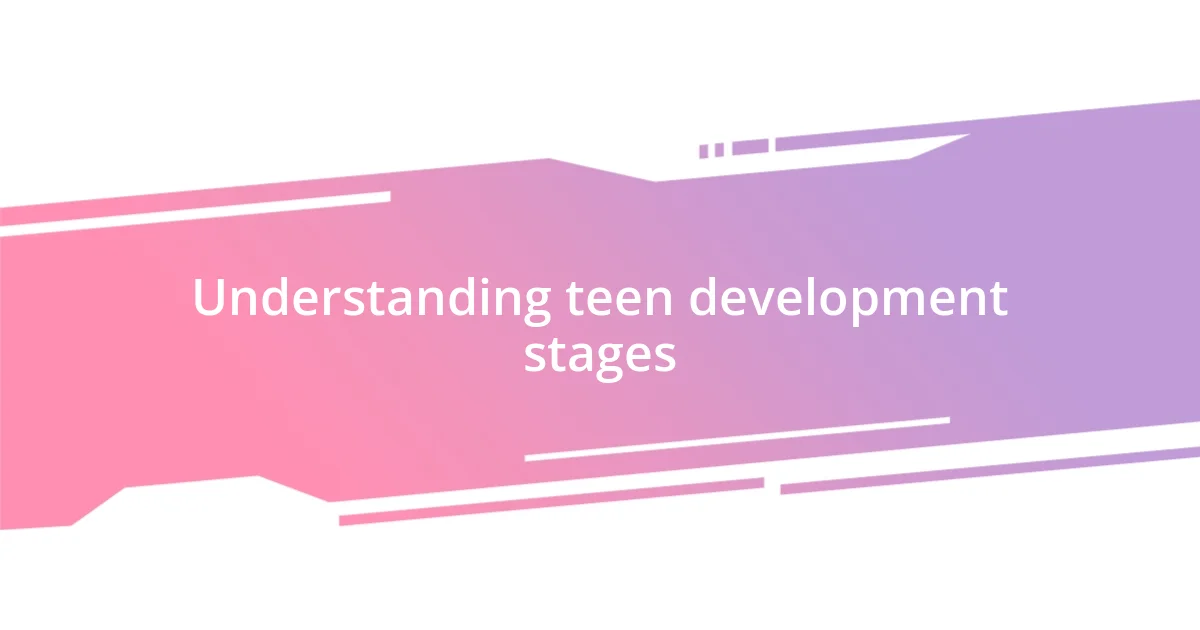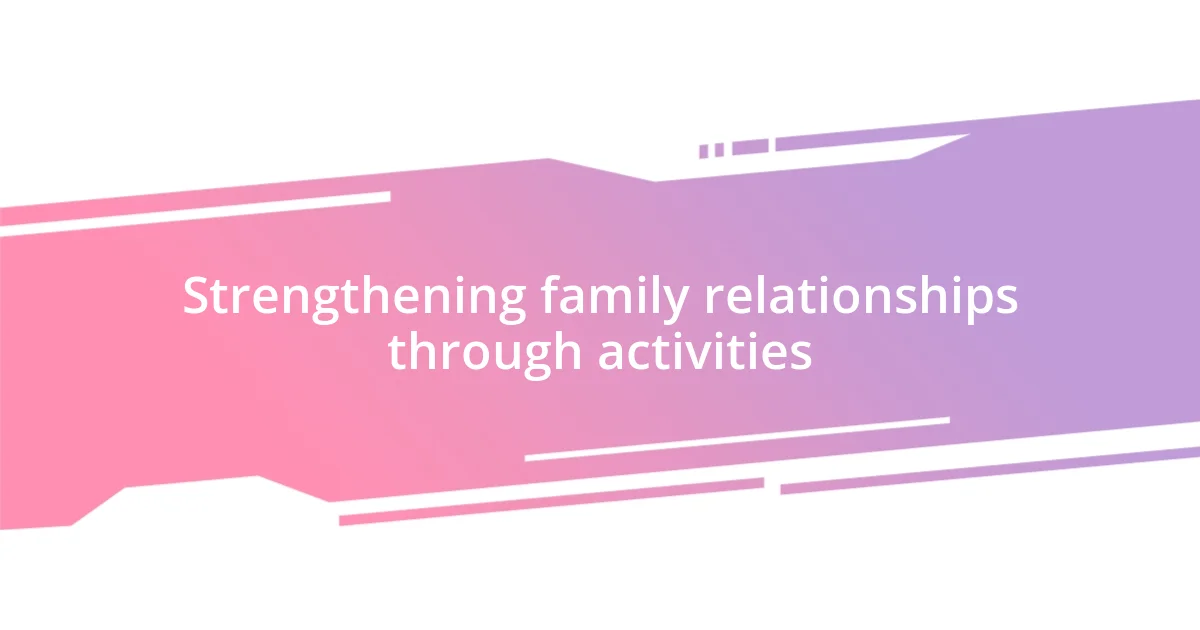Key takeaways:
- Understanding the stages of teen development is crucial for parents, balancing support with independence as teens shift emotionally and socially.
- Establishing open communication through casual discussions, active listening, and sharing personal experiences fosters trust and connection with teens.
- Encouraging independence and responsibility through assigned tasks and collaborative family activities strengthens relationships and builds valuable life skills.

Understanding teen development stages
Understanding the stages of teen development is crucial for any parent navigating this complex time. I remember the rush of emotions as my teenager transitioned from that carefree child into a more self-reliant individual. It’s a rollercoaster, isn’t it? One moment they’re seeking guidance, and the next, they’re asserting their independence, testing boundaries, and questioning authority.
During early adolescence, which typically spans ages 11 to 14, teens begin to shift emotionally and socially. I noticed my child becoming more introspective, sometimes moody, which made me wonder—are they crafting their identity or just going through a phase? It’s a mix of excitement and worry, as they explore friendships that sometimes take precedence over family. I realized that during this period, it’s essential to create a space where they feel secure enough to share their thoughts without judgment.
As they move into later adolescence, around ages 15 to 18, the focus often shifts to building deep connections and contemplating their future. It struck me how often my teen would come to me for advice on critical life choices, yet just as frequently assert their desire for autonomy. This duality can be confusing, not just for them but for us as parents too. Understanding these stages helps me provide guidance while respecting their growing desire for independence; it’s about striking that delicate balance between support and freedom.

Establishing open communication methods
Establishing open communication with teens can be challenging yet rewarding. I remember a time when I initiated regular “check-in” conversations with my teenager. These weren’t formal sit-downs; instead, they were casual chats during car rides or while doing chores. This approach helped create a relaxed environment, making it easier for my child to share thoughts and feelings without feeling pressured.
It’s essential to listen without immediately jumping to advice. I learned this the hard way when my teen vented about a tough day at school, and I instinctively wanted to solve the problem. Instead, I held back and practiced active listening, which opened up a more profound dialogue. By validating their feelings and letting them lead the conversation, we built a connection that fostered trust and understanding over time.
Additionally, being open about my own experiences has strengthened our communication. I often share relatable stories from my past. For instance, when discussing stress during exams, I’d recount moments from my school days where I faced similar challenges. This not only humanizes the discussion but also helps my teen perceive me as someone who understands their struggles. Finding that balance and being relatable makes an enormous difference in keeping the lines of communication open.
| Communication Method | Pros |
|---|---|
| Regular Check-ins | Creates relaxed sharing opportunities |
| Active Listening | Builds trust and deeper connections |
| Sharing Personal Experiences | Enhances relatability and understanding |

Setting boundaries and expectations
Setting boundaries and expectations in parenting teens can feel like a tightrope walk. I remember the first time I had to enforce a curfew. My teen was frustrated, convinced they were old enough to stay out later. Through that experience, I learned that clear boundaries actually provide a sense of safety. When they understand what’s expected, it helps alleviate some of their anxiety and confusion about rules.
Here’s a simple framework I found helpful when establishing boundaries:
- Be Clear: Clearly articulate your expectations regarding curfews, screen time, and responsibilities at home.
- Involve Them: Engage your teen in discussions about rules and boundaries. This sense of ownership often leads to better compliance.
- Consistency is Key: Once boundaries are set, it’s essential to stick to them. This consistency builds trust and respect.
- Flexibility: Be willing to adjust the rules as your teen matures. Openly revisit expectations to adapt to their growing independence.
Finding the right balance isn’t always easy, but I’ve realized that it’s crucial for fostering trust and mutual respect.

Encouraging independence and responsibility
Encouraging independence in teens often feels like setting them free to discover the world on their own terms. When my daughter started driving, I handed over the keys with a mix of pride and anxiety. I remember saying, “You have the freedom to explore, but always keep responsibility in mind.” This simple reminder transformed our relationship; she began making decisions independently, which built her confidence but also taught her the importance of accountability for her actions.
One effective strategy I found was to assign responsibilities that matched their interests. For instance, I encouraged my son to manage his own school projects by organizing deadlines and checkpoints. I still recall the excitement in his voice when he completed his first major assignment without my intervention. “I did it, Mom!” he exclaimed. This not only empowered him but also showed him that he was capable of tracking his commitments, reinforcing the idea that independence comes with responsibility.
It’s fascinating how small steps can lead to significant growth. I often reflect on moments when my teens made choices that surprised me, like volunteering to help a neighbor with yard work without me suggesting it. Those instances reminded me that when we allow our kids to take on challenges, we cultivate their ability to navigate life’s complexities. Isn’t it rewarding to witness their progress and to know you’ve played a part in fostering their independence? I feel proud knowing that as parents, we plant the seeds of responsibility that can blossom into invaluable life skills.

Navigating conflicts with empathy
Navigating conflicts with empathy is a game-changer. I recall a heated argument with my son about his homework habits. Instead of reacting impulsively, I took a breath and asked him how he felt about the pressure he was under. By approaching him with understanding, I was able to see that he was overwhelmed rather than rebellious. This opened up a dialogue that transformed our conflict into a collaborative problem-solving session.
When both my teens and I find ourselves in the middle of a disagreement, I try to remind myself that it’s not just about the issue at hand, but also about how my response shapes our relationship. I remember a time when my daughter wanted to quit a sport mid-season; instead of dismissing her feelings, I asked what was making her unhappy. Her face lit up as she shared her struggles, and in that moment, I learned that sometimes, all they need is someone to listen deeply and validate their feelings. Isn’t it powerful how a small shift can lead to deeper connections?
Empathy has also taught me to take a step back and evaluate my own emotional reactions. There have been instances when I felt disrespected, and my initial instinct was to defend myself. However, when I paused and tried to understand the root of their feelings, it often revealed unmet needs on both sides. This insight has allowed me to respond with compassion rather than frustration, paving the way for healthier discussions. Who wouldn’t want to turn conflicts into opportunities for growth, both for ourselves and our teens?

Supporting mental health and well-being
Supporting mental health and well-being in teens requires staying attuned to their emotional needs. I remember a period when my daughter appeared distant and withdrawn. Instead of brushing it off as typical teenage behavior, I decided to carve out some time just for us—an evening of her favorite movies and snacks. That simple, relaxed setting encouraged her to open up about her feelings, reminding me how essential it is to create inviting spaces for conversations about mental health.
Another approach I found effective is practicing mindfulness together. One Saturday morning, I suggested we try a guided meditation app I’d discovered. To my surprise, she was willing to join me. As we sat quietly, breathing and focusing our thoughts, I noticed a shift in her demeanor. When the session ended, she shared that it had helped her feel more grounded. Isn’t it remarkable how exploring new activities can strengthen emotional resilience and provide coping tools for teens? These moments show them that mental health isn’t just an individual concern: it’s something we can navigate together.
Furthermore, I’ve learned to encourage open dialogue by being vulnerable myself. During one emotional week, I candidly shared with my son how I struggled with my own stress. He looked at me with wide eyes and said, “I didn’t know adults felt that way, too!” It struck me that normalizing these feelings helps demystify mental health concerns for them. Don’t you think that when we model openness about emotions, we create an environment where our children feel safe to express themselves? It’s these heartfelt exchanges that foster genuine support and connection, enabling them to prioritize their mental well-being.

Strengthening family relationships through activities
One memorable activity that significantly strengthened our family bonds was our weekly game night. I remember the laughter erupting as we played board games, completely forgetting the stress of the week. It became a cherished tradition, creating a space where we could let loose and engage in friendly competition. Have you ever noticed how a bit of fun can break down walls between family members? Those evenings weren’t just about games; they were about connection. They paved the way for genuine conversations, letting us share thoughts and feelings in a lighthearted environment.
Another fantastic experience was our impromptu cooking sessions. After a long school day, I invited my teens to join me in the kitchen, and to my surprise, they embraced it wholeheartedly. As we diced veggies and stirred sauces, we swapped stories and shared our daily highs and lows. I found that cooking together not only taught them essential life skills but also deepened our connections. It’s incredible how simple actions, like preparing a meal, can turn into meaningful conversations. What could be more satisfying than bonding over a delicious dish we created as a team?
A particularly touching activity was volunteering together at a local shelter. Initially, my teens were resistant, but once we got there, their attitudes changed. Seeing their smiles as they helped others ignited a sense of purpose in them. We spent the day organizing donations, enjoying each moment as a family, and discussing the impact of our actions. Isn’t it uplifting how caring for others can strengthen our family ties? Those experiences not only rooted us deeper in our values but also created lasting memories we can cherish for years to come.














